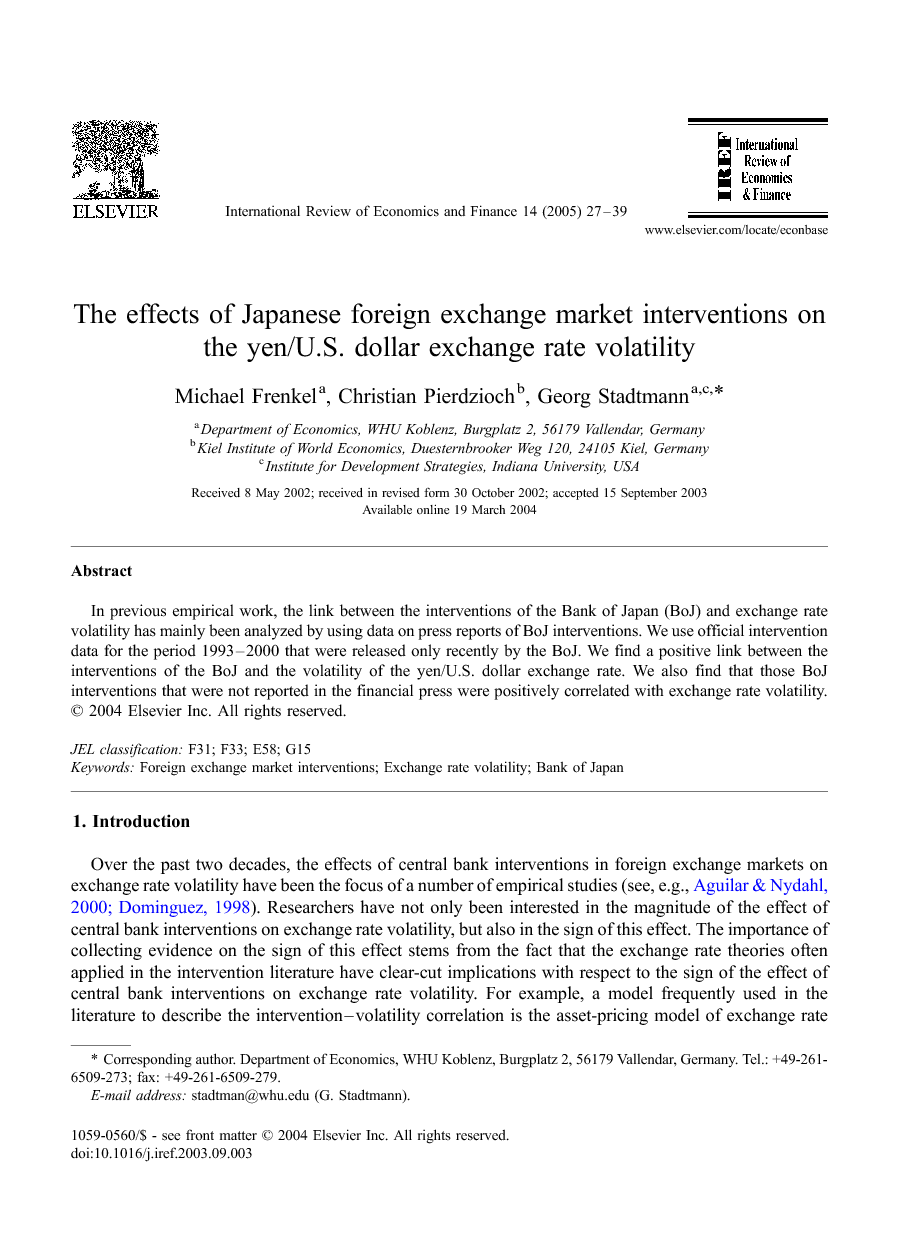In previous empirical work, the link between the interventions of the Bank of Japan (BoJ) and exchange rate volatility has mainly been analyzed by using data on press reports of BoJ interventions. We use official intervention data for the period 1993–2000 that were released only recently by the BoJ. We find a positive link between the interventions of the BoJ and the volatility of the yen/U.S. dollar exchange rate. We also find that those BoJ interventions that were not reported in the financial press were positively correlated with exchange rate volatility.
Over the past two decades, the effects of central bank interventions in foreign exchange markets on exchange rate volatility have been the focus of a number of empirical studies (see, e.g., Aguilar & Nydahl, 2000 and Dominguez, 1998). Researchers have not only been interested in the magnitude of the effect of central bank interventions on exchange rate volatility, but also in the sign of this effect. The importance of collecting evidence on the sign of this effect stems from the fact that the exchange rate theories often applied in the intervention literature have clear-cut implications with respect to the sign of the effect of central bank interventions on exchange rate volatility. For example, a model frequently used in the literature to describe the intervention–volatility correlation is the asset-pricing model of exchange rate determination. As discussed in detail by Dominguez (1998), this standard, forward-looking rational expectations exchange rate model implies that, due to its stabilizing effects on agents' exchange rate expectations, a credible central bank intervention should either dampen exchange rate volatility or should not affect exchange rate volatility at all. If, in contrast, interventions are not credible, or the monetary authorities send out ambiguous signals, central bank interventions should amplify exchange rate volatility.
We provide evidence on the sign of the intervention–volatility correlation by using a new official data set on Bank of Japan (BoJ) interventions in the yen/U.S. dollar foreign exchange market.1 In the past, official data were, in general, not available to researchers because the BoJ did not release official data on its intervention behavior. Lacking official intervention data, previous studies mainly used intervention reports in the financial press to analyze the link between BoJ interventions and exchange rate volatility (see, e.g., Bonser-Neal & Tanner, 1996, Dominguez, 1998 and Galati & Melick, 1999).2 However, as we argue in this paper, for the sample period we analyze, intervention reports in the financial press are likely to represent a relatively inaccurate proxy of the actual BoJ intervention policy. The analysis we present in this paper is not subject to this inaccuracy because we use official intervention data that were recently released by the BoJ to test for the link between the interventions conducted by the BoJ and the volatility of the yen/U.S. dollar exchange rate. To measure exchange rate volatility, we use volatilities implicit in foreign currency options.
Our key finding is that the BoJ interventions were positively correlated with the volatility of the yen/U.S. dollar exchange rate during our sample period 1993–2000. This effect tends to be particularly strong for those (“secret”) BoJ interventions that were not reported in the financial press. We also find a positive link between interventions and exchange rate volatility for the U.S. dollar purchases of the BoJ. Our results also indicate that the coordination of foreign exchange market interventions between the BoJ and the Federal Reserve (Fed) did not change the positive sign of the intervention–volatility correlation.
We organize the remainder of the paper as follows. In Section 2, we lay out the quantitative model we use in our empirical analysis and describe some stylized facts of the official BoJ intervention data. In Section 3, we present our empirical estimates and discuss our results. In Section 4, we conclude.
In this paper, we have used recently released daily official BoJ intervention data to analyze whether the foreign exchange market interventions conducted by the BoJ during the period 1993–2000 were correlated with the volatility of the yen/U.S. dollar spot exchange rate. Our findings suggest that during the period under investigation, the BoJ interventions were, on average, positively correlated with the yen/U.S. dollar exchange rate volatility. Moreover, our findings indicate that especially secret BoJ interventions, that is, interventions that were not reported in the financial press, tended to be correlated with an increase in exchange rate volatility.


